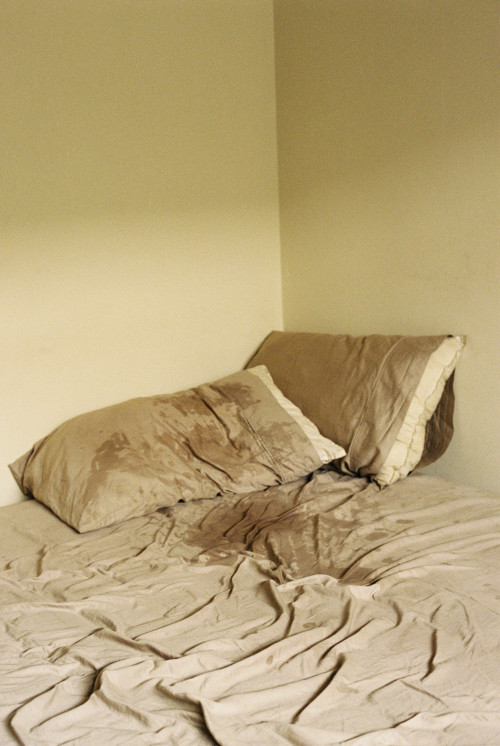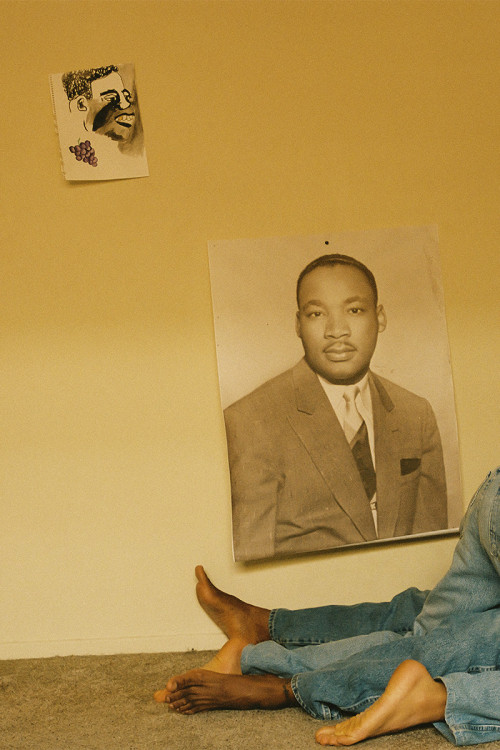Clifford Prince King is a Black American artist. His still images and video work have largely focused on the intimacy between Black people, often queer, in domestic settings and has been exhibited widely, including at the Los Angeles County Museum of Arts and at MASS MoCA (Massachusetts Museum of Contemporary Art).
His first monograph, Orange Grove, captures a life lived and imagined as a young person coming into his own.
But something is changing for King, in his work and life. He is entering a new era as his 30th birthday approaches. In the interview below, he reflects on the past three years and the role HIV plays in his life and work and celebrates being alive now.
The occasion for the interview was the exhibition Hush-a-bye Dreams at New York City´s Gordon Robichaux gallery through April 30, 2023, which includes new work, as well as images from Orange Grove and his early career, including Track Star (2017), which is discussed below.

“Track Star” (2017) by Clifford Prince KingClifford Prince King / Courtesy of Gordon Robichaux
Kerr: Kiss of Life (2022), a short film you made for Visual AIDS, is a series of poems and moving images juxtaposed between two people living with HIV, both Black, from different generations talking about their experiences.
King: The age thing was really important to me. Michael, the older gentleman, is a friend that I met through a friend at The Bullet, a bar in North Hollywood. It was a few days after my HIV diagnosis. I went there alone and together they counseled me through that early time. After that, I started going to the bar to hear their stories. They really helped me. So for Kiss of Life, I wanted to include the voice of someone who has lived through the epidemic in the ’90s as an umbrella for what we are going through now but also to share what can happen when we listen to people who have come before us.
What was your knowledge of HIV before you got to talk to people like Michael?
Before my diagnosis in 2018, I was maybe a year into coming into my sexual freedom. My relationship to HIV at that time was just centered around pain and suffering from what I’ve heard and how it has been portrayed. And so it was something that I avoided or didn’t necessarily want to dive into. It was like a phantom or something.
In the film, there is a moment of conflation between being Black and queer with HIV. Michael says something like, “If I was to meet a straight person…” and by straight, I think he means HIV negative. For you, is there an entanglement between race, sexual identity and HIV status, and if so, how are you dealing with it?
I’m still figuring that out. Subconsciously, I associate Blackness and queerness, and then there are things that are potentially added on later in life. I would say HIV would be one of them, just because of statistics and history. But I mean, it’s not the best thing to always group all three together or assume the fate of every queer Black person.
I think a reason I’m so vocal about my status is to show people someone who is open about their status. I know in a lot of Black and brown families, parents can be fearful for their gay children because of the way things like HIV have historically been talked about. So I think it is important for them to see people, like me, actually succeeding and doing things in a healthy way, including living with HIV.
And when it comes to work, I know a lot of artists who are HIV positive, but they don’t necessarily want to speak on it because they don’t want to be an activist for it or for their status to be their byline. There have been times where I’m being interviewed or written about and the introduction is like, “Here he is—queer, Black and HIV positive.” And I am like, “Can you just remove like two of those things? Or like, at least just HIV because I don’t think that defines the work.” It is there in context.
How would you write your own introduction?
I’m really bad at stuff like that, but I would just say, “Black American artist and queer,” but that last word is more complicated. Sometimes, I understand myself to be just gay, or even pansexual, which is something I’m trying to also figure out.
I get that. In terms of identity and work, it seems to me, from the outside, that a lot of your success as a photographer, your emergence as a young adult and as someone living with HIV all kind of bloomed at the same time.
It was a matter of three or so years. I was diagnosed with HIV in 2018, then 2020 happened, including the Nan Goldin issue of Aperture, which kind of catapulted a lot of things as far as people who were interested in my work. And now, I’m turning 30 this year. So it has all happened in this one era that I think is coming to a close. I can’t move in the same way I did when I was 27, which is fine because I’m trying to move differently anyway. I don’t think I need to take pictures of boys in bed anymore. I can dig a little deeper, and as I get older, I feel more available mentally and physically to do more research, photography and writing.

“Night Sweats” (2018) by Clifford Prince KingClifford Prince King
I see that this era that you are suggesting is ending, as starting with your photo Night Sweats (2018) and that photo Paul Mpagi Sepuya took of you, unbeknownst to him, around the time of your diagnosis.
I was helping Paul out in the studio, and I was in my HIV incubation period, that time where you’re not on your medicine yet, and you can feel your body fighting something. I think of this time in my life, and it’s like a hero’s journey—moving to Los Angeles, running around and compiling all the newness and then feeling the slowdown or the turning point where you wonder if this is my life now. And it was from that point, a low point, that I began to slowly build myself up by continuing to work and make myself happy again. That era is like a saga of events, and, not to be cheesy, but I do feel like my photographs act as a visual diary. Looking back, it is like I am watching kids from the Disney Channel grow up. Like Miley Cyrus had her Bangers era, I, too, got a little messy.
Your Night Sweats is Miley’s “Wrecking Ball.” Both are intimate snapshots of an artist in transition, dealing with big issues.
Oh my God! [Laughs] When I released Night Sweats, no one around me knew what that was. People thought it was like sex juice or something. But actually, if you search for night sweats, you see it’s an HIV symptom. But also, my work does function in this area of innuendos, right? I don’t really use captions. I hate titles. People make the work make sense for them. I remember there was one person, a straight guy from Haiti, and he was talking to me about how hard it is to sleep in hot climates. And I was like, Oh, OK. But still for me, Night Sweats reminds me of that overall feeling of panic and uncertainty. Like, your body is telling you something, overworking and trying to get rid of something. I feel like HIV was my first notice I had of my body fighting for itself.
Was HIV something you and the people in the Orange Grove work would talk about?
No. Most of that work was before my diagnosis. After I got the news, I did not really hang out with many people for, like, three months. And even after I was undetectable, it took me a while to share my status. I would only share it if someone shared it with me. Or maybe more so with serious partners, and even then, it can be hard. Four weeks into this relationship, before we even started having sex, I told this guy I was HIV positive outside a bar and crying started.
You started crying, or he did?
I did. I was so scared of him being—I don’t know. But I learned that giving people the benefit of the doubt is important. I think I psych myself out before I tell someone, and in so many cases, they are like, “Oh, well I’ve been with people before” or like, “You know, I’m on PrEP (pre-exposure prophylaxis).” The gays are smart, you know. So yeah, I was crying, and then he’s like, “Oh, it’s fine.” His reaction made me more attached to him, which is something I had to process after he broke up with me. Also, there is that thing that happens when you date someone else living with HIV: positive trauma bonding.

“Poster Boys” (2020) by Clifford Prince KingClifford Prince King
There is a lot to consider.
Yes, and I get messages from younger people who thank me for being open. And so I know there are a lot of people not comfortable really talking about their status with their friends or even publicly. It takes time, or maybe it is not even necessary? I definitely haven’t been the best at disclosure, even though I am already so public about it. But sometimes, there’s just something that keeps me from saying it. It’s almost like, Why would I tell you something so big about myself, and I don’t even know you. Why would I share something so important to me and maybe we just met? Disclosure almost feels like I’m committed to someone without even knowing what is about to happen. Maybe it is not going to be good, and now I have told you something beautiful about me. You don’t deserve that knowledge yet.
I like the way you put that.
I am not sure how to say this, but there is something about the intense ways people talk about HIV that can make the experience of it actually underwhelming as you live it. After my diagnosis, I started taking care of myself a lot by going to the gym and the doctor more and taking vitamins. I thought HIV would change my life in all of these big negative ways, and all I can say is that it has been underwhelming.
Does it come down to a hierarchy of risk? Maybe the cultural noise around HIV is louder than what we hear about issues that are just as pressing and maybe pose more of a risk.
Definitely. There is this documentary called Party Boi: Black Diamonds in Ice Castles, and it is about Black and brown queer guys and meth use. I have been trying to see it for the last five years because back when I was living in Burbank, California, and I was on the dating apps, there were all these young boys trying to get me to come over and smoke with them. I did, but it was bleak. No one had slept, and there were so many people in the apartments. I just wanted to know what is going on. I carry around Narcan (an easy way to reverse an overdose) because we know people are going to do drugs, and so I just think we need to invest in facing this reality because it is worth it. People are worth it. I’m trying to write this feature, and I think it’s going to revolve around normalizing drug use but also the repercussions while being rooted in an understanding that basically we all do drugs.
A photography question: Do you see the images that include Martin Luther King (Poster Boys, 2020) and Jesse Owens (Track Star, 2017) as being connected to your Robert Rayford (Robert Rayford, 2020) image? They all contain interior space, images of remarkable Black men on a wall, surrounded by Black men in the present.
Yes. The start of all those images is history, and my love of bringing something from the past into the present. I like to have art within the art. Especially when it comes to collage and layering and time. Like the way new music can sample an old song, and then that old song will trend on Twitter. A lot of my work is like this, sampling older stuff that I missed, like Essex Hemphill, and bringing it forward. I want to reference these people, and then I hope someone will look them up and learn about them.
But also, each of those images you mentioned are different. For example, the Martin Luther King one is about bringing queerness and Blackness together because they can be so separate.
What about the one with Robert Rayford?
I forget how I even learned about him. I think I typed in “first AIDS patient” or something. And then he came up, and I was like, Oh my God, poor baby. And then he became this deity in my head and because I like living with things on my walls I knew I had to do something. So I made a Xerox of an image I found online and put it up on the wall and let that be my altar for a few weeks.
How do you feel that the person in your collage is not Robert Rayford?
I think it makes it stronger.
Me too.
Robert can be anyone.

“Robert Rayford” (2020) by Clifford Prince KingClifford Prince King
I think it is important to state that the person in the Xerox was a real person and has nothing to do with HIV, but also, I think I hear what you are saying about the openness. I feel like the lack of information available about Robert, and HIV history in general, is its own context. Another way of saying this: Your desire to have history around you after you were diagnosed is its own fact that you are inviting us as viewers to wrestle with.
And it shows you how things get so lost, in history, in translation. There are a lot of layers of information not getting passed on when you think about it: like information about health care or even community. Soon after I was diagnosed, I tried going to a support group I found online. It was somewhere in Hollywood. I showed up, and they were like, “Oh, we don’t have that group anymore.” But then this nice old man took me upstairs, sat me down, was like, “So let’s talk.” And I was like, “This is sweet, but you don’t have to.” Instead, eventually I went to The Bullet, and that was how I ended up meeting Michael and other guys who shared their stories with me. And I have to say, all of this makes me happy to be alive now. I am someone who has often thought, Oh, I wish I was there in the 1970s or whatever, but I am grateful for what I have now, and who I can be now.
Canadian-born Theodore (ted) Kerr is a Brooklyn-based writer and organizer whose work focuses on HIV and AIDS, community and culture. Go to tedkerr.club for more information.
Go to cliffordprinceking.com to learn more about Clifford Prince King.







Comments
Comments